Interview by Avery and Ollie Kaplan

Skybound Comet and Image Comics recently released Family Force V, written by Matt Braly, the creator of Disney’s Amphibia, and illustrated by Ainsworth Lin, a character designer for animation who’s brand-new to the comic scene. This coming-of-age graphic novel follows Maise, a normal teenager who also saves the world from alien kaiju along with her alien-fighting, superhero family.
“Fighting alien kaiju with your family on a Friday night is a totally normal part of being a teenager…right?,” reads the OGN’s official logline. “Well, it is for Maise who, despite her protests, continues the family legacy of keeping the world safe, all while trying to get good grades, impress her crush, and balance extracurriculars.”
The Beat interviewed Braly and Lin to discuss their collaborative process, what inspired Family Force V, and how the story explores grief.
This interview has been edited for clarity and length.
AVERY AND OLLIE KAPLAN: Can you introduce yourselves?
MATT BRALY: I’m Matt Braly. I was the writer of this book.
AINSWORTH LIN: Hey, I’m Ainsworth LIn. I was the artist of this book.
KAPLAN: We’re so excited to discuss Family Force V with you today. What was the genesis of this story?
BRALY: I worked at Disney for like 11 years, in this very specific 6 to 11 age demographic, which was very tricky. When you’re targeting that demographic, you want to reach 6-year-olds and 11-year-olds, but, as you know, the difference in taste between what a 6-year-old likes and what an 11-year-old likes, is worlds apart—the amount of development and changes that happen there. So, for my next project, I wanted to target a little bit of an older space, maybe 11 to 15, 11 to 16.
Skybound, the publisher, was a fan of the show I made at Disney, called Amphibia, and reached out about some pitches. So, I pitched them a few ideas, and Family Force V was sort of the stickiest, where they heard it and were like, “Oh, that’s, that’s fun.” What I pitched was, in the vein of my favorite projects, especially Gravity Falls and Steven Universe, which did this wonderful thing of marrying the mundane with the fantastic.
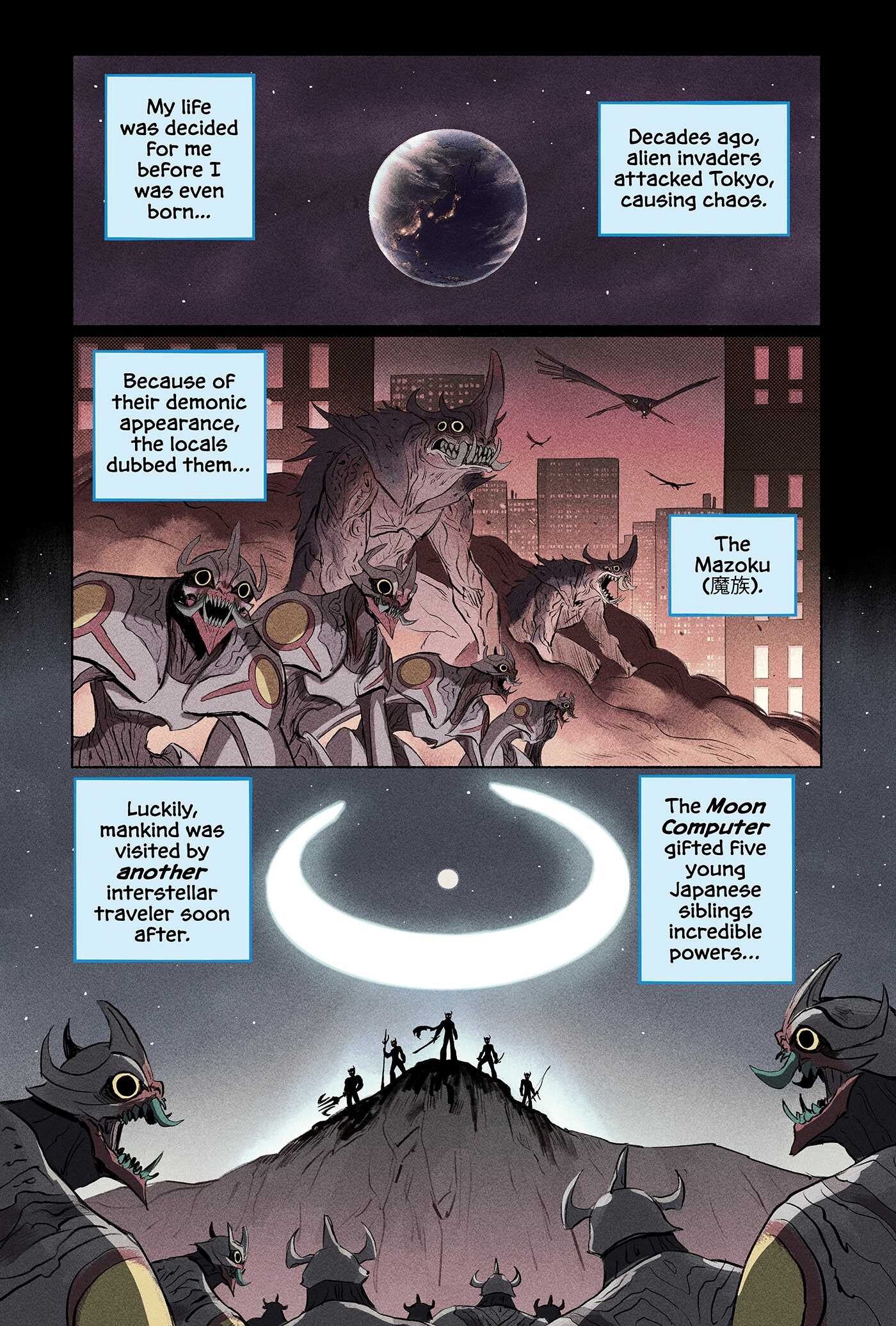
KAPLAN: It worked so well.
BRALY: Like Gravity Falls, where you have a weird town in the Pacific Northwest, but magical things are happening that help to tell stories about what it’s like to be 12 years old, you know? Or Steven Universe, set in this beachside town, about a kid who’s just a kid growing up, but also his guardians are these living, sentient, magical, gem people, you know? However, he’s also going through normal kid things, like making friends and maybe dating someone. And so, with this pitch, I wanted to target combining the mundane with the fantastic, and what we settled on was sort of like Power Rangers, but if it was like a family business or an obligation sort of thing. So, that’s how the pitch started.
The pitch was Power Rangers meets Incredibles but from the perspective of Violet, like the young teen character in the family who is honestly feeling a little bit choked by all this responsibility.
KAPLAN: We definitely picked up on the Power Rangers inspiration. And actually, we wanted to ask more about influences, both for Braly’s writing and for Ainsworth’s art.
BRALY: I’ll get to the writing, and then Ainsworth will take the art. Basically, influence-wise, I looked at things like Avatar the Last Airbender and Demon Slayer, something that my editor and I talked a lot about was Demon Slayer. We were just like, “Can you believe that’s for 13-year-olds? Isn’t that crazy?” So, we were like, “Let’s see if we can push the stakes in this story,” like maybe people die, and the danger is real, and the emotions are high. We were— again, in service of maybe aiming a little bit older this time— going for those genuine feelings that are perfect for stories about teens. When you’re a teen, you feel all these emotions as very extreme feelings, and so when stakes are high (like the physical danger is high), it typically marries very well.
But, I come from a comedy background. So, of course, we tried to make these characters very charming, funny, and light on their feet.
LIN: For the art side, obviously, when we were designing the characters we had the Power Ranger‘s Voltron influences. Our original sketches were more aligned with that kind of skin-tight suit aesthetic, then we decided to go for a more sci-fi-esque appearance with more armor and stuff like that. And Matt came up with the idea of the eyes being like LED lenses, or whatever, and you see the flickering kind of effects going on. It’s super cool, and I love it a lot.
Then, we have the moon aesthetic, too, with the half-crescent moon going on because we have Moonie, who’s like the alien AI thing in their basement. And, I mean, the whole moon aesthetic is just pleasurable. They’re also called moon troopers; the half-crescent moon is everywhere.
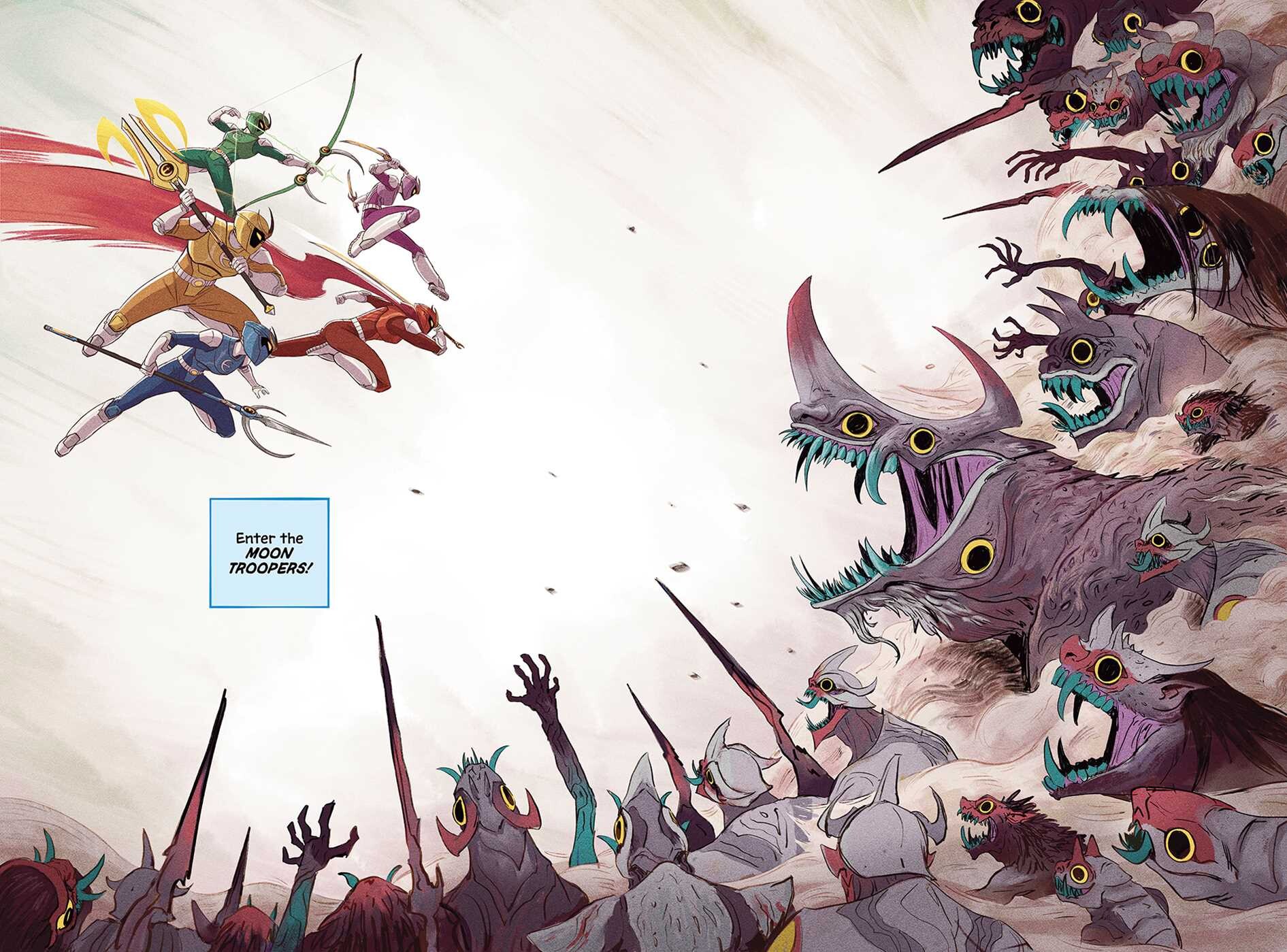
KAPLAN: So, we have a couple of questions about the character pages. Specifically, we’re curious about how you pronounce Ms. Rogers’ first name.
BRALY: It’s Giffany, with a soft G. Yeah, for me, it’s soft. I think like, “Oh, Jiffany, you know, like Jiff?” But, you’re not wrong if you read, “GIF” with a hard G.
KAPLAN: The age-old debate, GIF for Jiff.
BRALY: I know. I prefer the soft G. It’s so smooth, and it flows in conversation, but what do I know?
KAPLAN: I’m with you. I like to pronounce it like the peanut butter brand.
BRALY: Oh, good.
KAPLAN: We also want to ask about the decision to use pronouns on the character pages.
BRALY: Yeah, 100 percent. In Amphibia, I wanted a non-binary character and could never pull it off. You know, when working for such a big company, there was so much scrutiny and process that you couldn’t do these things without the entire kind of ship behind you if that makes any sense. So, when I sat down to do Family Force V, I knew that I wanted to finally have that non-binary character, and I wanted it to be indisputable. Like, even though in Amphibia, there’s a character named Terri, who is pretty non-binary coded, until you see the pronouns next to the name and you make it official, it’s disputable. I feel like here in Family Force V, it’s a hundred percent; it’s inked on paper: “This is a non-binary character. This is their identity.”
Once you do it for one character, you do have to do it for all of them, otherwise, it’s weird. Then, when we got to Moonie, the computer, I wasn’t sure what to put. So, it’s blank.
LIN: Yeah, it’s blank.
BRALY: For some reason putting something there, I felt like, “No, I’m not like making fun of Moonie.”
KAPLAN: Following up, because something I’ve heard talked about in my art therapy groups is designing a non-binary character, like how do you represent that identity on a page? I’m non-binary myself., so I did appreciate the rep.
LIN: Matt came up with the original sketch of Citlalli, and then I translated it into my style. Citlalli has a—I hesitate to call it dark academia—but how they dress is like a dark academia style. I gave them nice, very gender-neutral clothes, and they have a certain silhouette, more bulky on top with their little pencil legs on the bottom. That’s just who they are, so, you know, keeping that style consistent throughout their wardrobe, especially since that’s different for everyone. Like, for this character, since Citlalli was the hopeful love interest to Maisie, we were definitely after…well, they had to be really cool, you know what I mean? So, instinctively, we’re going for that kind of preppy look.
We looked at Mobile Suit Gundam Wing, which is a 90s classic, and the character, Trowa Barton, kind of inspired Citlalli’s look, too, which is very like big bangs going over one eye. It’s a very, very iconic and cool look. So I think that when designing the character too, we were just like, they have to be very cool. Also, I think Citlalli is the only character who changes outfits all the time; they’re very fashion-conscious. While everyone else has the same clothes, Citlalli has four outfits or something. Clothes are expression.
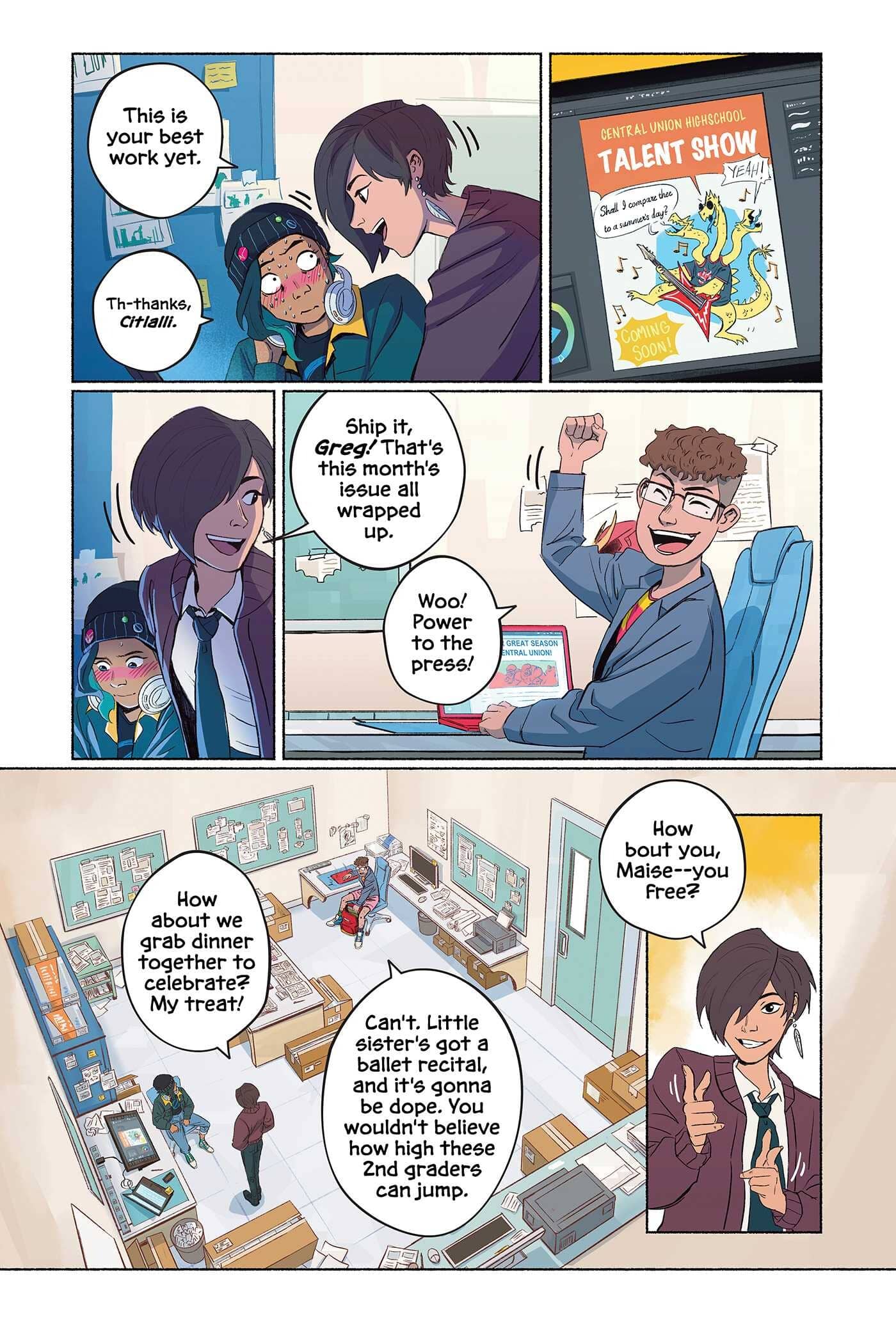
KAPLAN: This question is for Ainsworth, but Matt, you can answer too. What is your In-N-Out order?
LIN: Oh my god, okay. So double, double animal style with whole grilled onions, well-done fries, and a pink lemonade.
BRALY: This is because Ainsworth’s profile has an In-N-Out order, right? I don’t have an In-N-Out order.
LIN: In-N-Out took my town by storm. When I was growing up in the 90s, I lived in this small town, Davis, CA, in Northern California. I remember when we’d go to In-N-Out, the line would be huge, people were crazy for this place. It was all about the fries; they were fresh, or hand-cut, and never soggy. I read an article about a year or two ago about In-N-Out opening up in the Midwest or something, and the line was down the freeway. Unbelievable. And, like people who haven’t had it before, they hate the fries because they’re soggy and stuff. I’m gross; I’m nostalgic for it, although I mostly get the well-done fries because they’re crunchier. Sometimes, however, I have the normal, soft fries—nasty, but I love it.
KAPLAN: In West Hollywood, it’s like always super busy. It’s been called a “public menace.”
BRALY: Geez, you’d think people would be over it by now. Do you guys know that there’s a bible verse on the cups? On the fries, too, I think. And that’s 100 percent because the CEO is like born again or something like that.
KAPLAN: Also, did you know IN-N-OUT had California’s first drive-thru?
BRALY: What? [Kaplan nods.] This is now like an In-N-Out podcast.
KAPLAN: I wrote an article about McDonald’s drive-thru, which is how I learned it. You would think it was McDonald’s, right? Except, they were one of the last, I think.
BRALY: I mean, I’m sure there was some like food stall like hundreds of years ago where you could bring your horse and buggy through, you know, strolled up to the window.
KAPLAN: Okay, we’re gonna switch to an entirely less fun topic. Obviously, the OGN explores grief, so was it important to you to include that element?
BRALY: This became a story about grief pretty early on. We’ve got this gal who is part of this family business, and like, she’s kind of fighting it, resisting it. So, the editor and I quickly concluded that we needed to completely shake up the status quo for this character and challenge her in ways that she was not expecting, which, unfortunately, meant that Ken [her father] had to die. When you do something like this, whether it’s a show or book, you have to be genuine. So, I feel like giving Maisie the space to grieve for, basically, the majority of the book, is her coming around on what has happened, getting out of this trap of blaming herself, and then sort of picking herself up and trying to move forward.
It’s funny, because we have like 10 chapters, right? We charted it out, and in Chapter 3, it says like, “Dad dies.” And then, in Chapter 7, which is many chapters later, it says like, “Maisie emerges.” Like, this is finally where she kind of comes out of this funk that she just spent the last four chapters in.
But yeah, the book is very much about grief, and the kind of responsibility that comes with that.
KAPLAN: I didn’t specifically look for this while reading, so do the chapters kind of follow the stages of grief? You know, so Maise can get through her trauma and experience post-traumatic growth?
BRALY: I feel like a few stages are missing. Like, I feel like we kind of skipped denial. I don’t think we have the characters ever question what has happened and what their lot in life is. I feel like this poor family, too, is kind of whisked along. You know, the new replacement shows up at their doorstep almost immediately, which again, brings a little bit of urgency, like, “Oh, this family has this big responsibility, and they can’t stop and take like a month to kind of like process it.”
KAPLAN: Obviously, Daichi’s grieving that relationship with his father that he doesn’t have.
BRALY: Yes, yes. And you know, I’m so glad we can talk about this since the book’s out, and we can just talk about spoilers. But like, yeah, Daichi comes and serves as sort of our antagonist for the book, although he’s not a bad guy. We did our best to humanize him, as well. He’s part of the family. He’s got a lot of pressure on him. Ainsworth, when he designed him, he made him very kind of like, “Well, this guy, he’s presenting,” you know what I mean? He’s like, “Look, how cool I am. I’ve got my piercings, bleached hair, and biker jacket.” But then, when you see him in front of the mirror, doing affirmations, you know that he’s a kid too.
One of my favorite moments is when he takes away Maise’s watch after he gets the order from his dad. And in the background, while everyone’s looking at Maise, you see Daichi is kind of conflicted. He feels really bad about doing this, but that’s something that he doesn’t show anyone else—that’s just something that we see as a viewer. I like how you can see the little cracks in his armor. It’s so good, and not in the script. Ainsworth did it.
I also like Daichi’s reaction when he realizes that he has taken her watch.
KAPLAN: I love that.
BRALY: I distinctly remember the conversation with my editor, where he was like, “Whoa, is Daichi too goofy here? Have we taken the stakes away if he’s suddenly flustered and goofy?” But actually, Maise is starting to come out of her funk, so Daichi would suddenly be not as scary to her. It’s time for Maise to kind of have a shift in perspective.
That chapter is one of my favorites because it has no fighting and no action. It’s just Maise taking a day to get away from the noise. She spends it with her friends at the mall, and then she comes home and spends time with her mom and her siblings. And she’s no longer fighting with Daichi, like, he says something like, “I’ve been pinging you. Where’s your watch?” And she’s like, “Bro, you took it.” He’s like, “Oh, right. Well, give me 100 push-ups,” and she’s like, “Sure.” Like, she’s not gonna fight him like that anymore, which is a big jump for her.
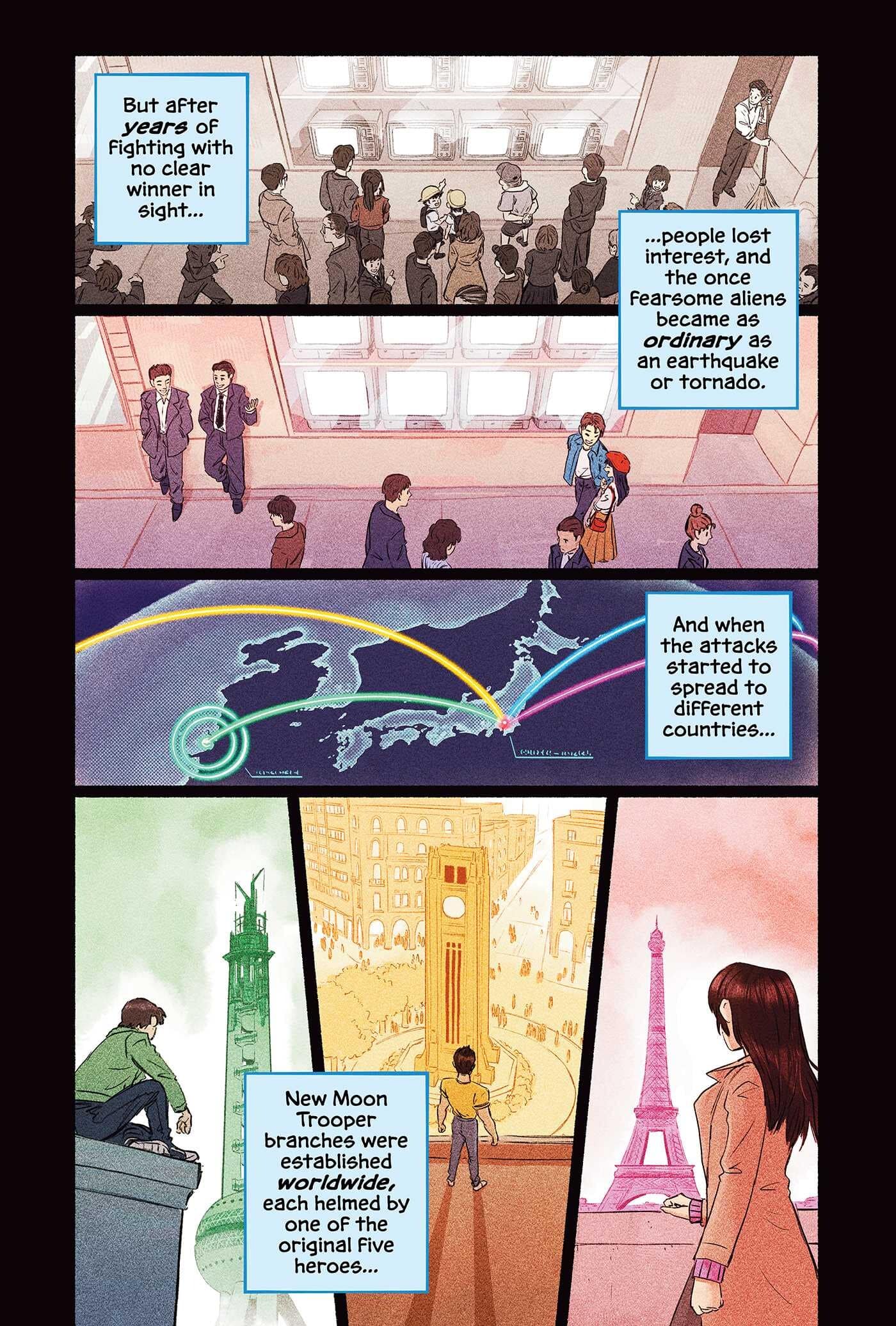
KAPLAN: What was it like collaborating on this project?
BRALY: It was awesome, and by the way, this is my first time doing any graphic novel writing. Graphic novel scripts are panel by panel, so like, in this panel, “Maisie slams her fist,” and in the next panel, “She points, and says, ‘You’re talking about dad,'” or something like that. So, this was my first time doing anything like that. When you do that, when you’re writing the panels and dialogue, you’re sort of doing so with the hope that the artist is going to take it and make it much better. So, I enjoyed the process of giving the scripts to Ainsworth, seeing his visual storytelling on the page, and giving us both the wiggle room for a push and pull, like maybe this is better as three panels, or maybe this line doesn’t work, or maybe this page just needs to be reformatted.
We were a small team. It was me, Ainsworth, the editor, and the letterer, and that was awesome. We were all very invested and constructive. When you have a big team, like 40 people, there’s a lot of space for someone to give a note just because they’re there. But yeah, Ainsworth, how was it for you?
LIN: Yeah, to be honest, the note portion only happened near the beginning. By the end, we didn’t have much. We just worked. Also, Matt writes super clearly (it’s not difficult to understand at all) and gives me a lot of material, too. His writing is great; it’s easily digestible. I could pump these things out, and the whole process was streamlined quickly. We probably knew what we were doing by Chapter 3, and I’m grateful for how easy it was to adapt.
BRALY: It was really good, like Gravity Falls. That show was wonderful because you would get a script, and it was already so funny. Like, you’d be flipping through it like, “Oh, my gosh, Mabel, you dog,” or whatever. But then, you put your visual hat brain on, and when there’s already this solid script it’s quite a fun process. I see what the point is and what the little character arcs are, so the question becomes, “How can I make it even better?” That is the best feeling. The worst feeling is when you get a script, and you’re like, “Man, I don’t even know what’s going on,” and then the poor artist has to kind of put their rewriting hat on, which is something we all have had to do. You know, sometimes it’s just not coming together.
So this was quite a nice, fun process where I think we were all like, yeah, let’s make this book awesome.
KAPLAN: You both come from animation, so how is that process different when it comes to adapting a script? I think that gets talked about a lot, but I’m still always curious about everyone’s perspective.
BRALY: On my end, it was a big adjustment because a screenplay is mostly about the passage of time on the page. For a screenplay, we have a general rule that it’s a page a minute. So, if you read a 60-page script, that’s like roughly an hour-long movie. For a comic, however, one page might be five seconds if it’s quick action, while another page might be 10 or 15 minutes if it’s an emotional conversation. So that threw me, where I was kind of like, “We’re like time masters.” This thing can push and pull in these really interesting ways, and you can take advantage of the medium. And so, I do think there was a big learning curve for me there. But, once I got the hang of it, it was a lot of fun…And then, just having pages where there’s no dialogue; that’s the greatest.
As a writer, I think sometimes you fall into the trap of, “Well if there’s no dialogue, what am I even providing?” But, that’s not true. Like, I’m still writing when the script says, “Maisie lies down on her bed and squeezes her pillow harder than she’s ever squeezed it before in her life.”
LIN: I usually do character design, so I used that portion of my skill set at the very beginning during the concept art phase, and then used the different part of my brain for the actual comic stuff. I was lucky that I took comic classes when I was in college, and I was able to apply that. I also took screenwriting classes, so reading Matt’s stuff was a breeze. So, it’s just applying different things I’ve learned in the past, which somehow nicely amalgamated into this thing in the present. So yeah, kind of got lucky on that.
KAPLAN: Ainsworth, were the comic book classes required for a degree at your school?
LIN: Oh, I just thought it was fun. I read Captain Underpants and Diary of a Wimpy Kid as a kid, and I would take the 8.5 by 11 sheets of paper, fold them into little booklets, and then make little comics out of them. They were garbage, but it was fun. I don’t know if I have them anymore. I’m pretty sure my parents threw those away at some point, but it’s fine. And so, I remember that as a kid, I wanted to be a comic artist. But then, as I got older, I was like, “Okay, I should probably just do some other job that pays well as an artist,” so I did concept art. Then, I found that really boring, so I went into animation. And now, I’m circling back around to comics. What a world!
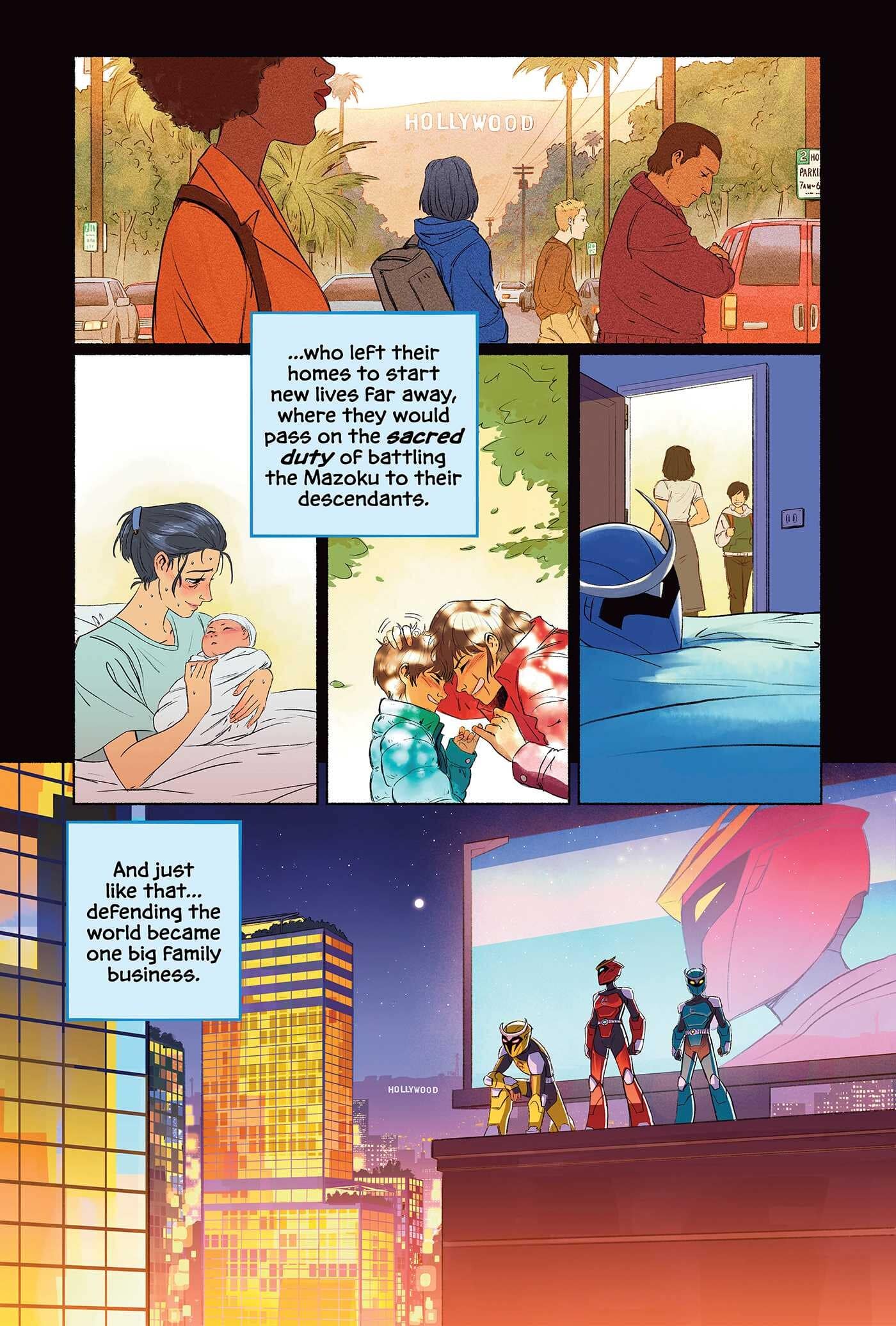
KAPLAN: What was it like working with Skybound on this OGN?
BRALY: Oh, they were great. I mean, when you think about Skybound, you think about The Walking Dead and Invincible. And like, this group who is already really dedicated to pushing the medium—make it crazier, make it quicker. Like honestly, when I sent the first outline, Maise’s dad didn’t die until the end of the book, and the editor was like, “No, no, no, no, he’s got to die in Chapter 2 or something.” I was like, “Oh, my God, that’s so fast,” but I think they had this ethos of starting the story when the story starts and then trying to keep the momentum up.
They were great partners, and our editor, his name is Alex Antone, was always fishing for the best story with the best character work. I feel like it was a really good experience in terms of like—let’s see how to say this—you work at a company like Disney, and there’s a brand to protect, so sometimes, with certain notes, there’s some subtext, like, the real reason Disney doesn’t want to do this story or this gag is because of some weird directive about how research instructed that kids no longer prefer stories that have X, Y, and Z, or something. But with Skybound, they’re more like, “Yeah, that’s rad. Let’s do it.” And I appreciated that for this project.
KAPLAN: That sort of mentality trickles down to every level of Disney. When I worked in the Disney theme parks, it was even like that.
BRALY: There are too many people, and everybody’s so nervous about, you know…they’ve all got these directives.
KAPLAN: What was it like working with your letter, JAME?
BRALY: We did a few auditions of different letters and different text styles, which is fascinating, because like, it can change the tone of the story based on how the letters look. JAME did amazing work and even did some of the sound effects when the need was there. Working with JAME was a really smooth, good experience, for the most part.
KAPLAN: I was wondering about the sound effects, letterer or artist?
BRALY: So in this case, Ainsworth did like 90% of them. They’re mostly hand-drawn. But then occasionally there were moments like, “Oh, we need a little something here,” and then JAME would pick it up for us.
LIN: The number of times I’ve updated our files on the server, it’s countless. Sometimes, I would make edits at 3 A.M. because I noticed a small little thing was not colored, and I wouldn’t say anything, I’d just drop it in quickly before sending the file off to get all the lettering done.
Also, JAME did the speech bubbles, too, and there were some creative ones. Like, when Maisie had the halo glasses on, and she’s supporting the family from afar by controlling some kind of robot drone. When she gets a text, there’s a cool speech bubble that shows the text that she got very clearly. Then also, it looks like G Chat or something, and it’s fun and inventive.

KAPLAN: Can we look forward to a sequel to Family Force V?
BRALY: Yes, hopefully. I don’t think we can’t confirm anything official today, but we’re talking about it. We’re having discussions about where the story should go. The premise has this big, juicy promise of an international family that has branches in Paris and Lebanon, and like, you want to meet these characters, you want to see if their costumes are the same, or if they are different. LI would love to do some kind of crazy tournament arc between the family, where there’s a competition that’s being televised and now the families are all competing.
KAPLAN: I love that idea. Fingers crossed. Is there anything else you want to include?
BRALY: I’ll say that if you have been sort of aching for (like I have) that genre niche that gets left behind a little bit in the West, which is that teen action, graphic novel, or show, I would highly recommend picking up this book. We worked hard to make the characters all feel funny and genuine, and also for there to be exciting stakes and action that would pair well with those characters.
I feel like teen animation is one of those things that Japan has figured out. Anime, you know what I mean? And like, everyone loves it. But in the West, there’s a little insecurity and nervousness when it comes to creating that kind of content, maybe in part because anime is so successful. Everyone’s like, “Ah, well, they got it covered. We’re good.” But no, I think that there’s more space for things like this—things like Avatar and Demon Slayer, and like we can age this stuff up a bit and have a lot more fun. So please, pick up the book if that’s your cup of tea.
KAPLAN: Ainsworth, did you want to add anything?
LIN: Oh, sorry, but my head was just thinking about other shows that were like that. Back in the day, we had, what, Ben 10, The Batman, stuff like that.
BRALY: Yeah, they just stopped. The action show is a lost art. And, you know, it could be anime, or it could just be that when cable died (or was dying), they were so desperately clinging to the 11-minute format because of attention spans shrinking, and the 11-minute format is not as good for action shows. So like, there’s so much going into this, but I agree that people would love that stuff. Like, you know, that new Spider-Man show is fantastic. And I do think there is a huge demand for this. It’s just about getting studios and companies on board.
KAPLAN: Yeah. Like Fiona and Cake, it’s sort of longer and aged up from Adventure Time.
BRALY: Exactly. When you’re a little bit older, the content gets to explore things like romance, existential crisis, real stress, angst, and trauma. Like, these things are well worth exploring, without having to go into the full, like, Blue Samurai mode, you know? There’s still a whole load of people in between that and like, Phineas and Ferb. What else does it?
KAPLAN: Well, Jurassic World: Chaos Theory.
BRALY: Exactly. So they’re out there. We just need about four times as many.
KAPLAN: Actually, I have one final thought. That Evanescence song.
LIN: Dude, I just saw a trailer for Elden Ring Nightreign, and it had “Bring Me to Life” playing in it.
BRALY: So what’s so funny about Maisie listening to “Bring Me to Life,” well, many things. Number one, that’s an old song, very old, and it dates me. But like, what’s so funny about that is that Family Force V very subtly takes place in the year 2025, but in a different timeline, where an alien showed up and made our society just a little bit more technologically advanced. And you can see that throughout the book. Ainsworth did an amazing job; there are hover cars, holographic projections, the moon computer, and moon gas, a new, sustainable, environmentally friendly gas for us. But ostensibly, this is still 2025. And while that’s a lot to chew on, it gets crazier: Now that we know that we’re in this alternative timeline, Evanescence still had a hit called “Bring Me to Life,” and it was popular enough that Maisie is listening to it decades after it came out. So, there are layers to this universe. It’s all very well thought out, breaking the fourth wall a little too.
KAPLAN: I remember dancing to Evanescence in high school.
BRALY: It has that crescendo, which is just good. She’s making a comeback recently, too. It was either Evanescence or My Chemical Romance. I feel like those are the two options, but Evanescence is a classier choice right now.
KAPLAN: We love that. We’re out of time, so let’s conclude by saying that Family Force V is available now at your local comic shop. Be sure and check it out.
BRALY: It will be available June 10, at Amazon and Barnes and Noble, or where books are sold.
Learn more about Family Force V at Skybound Entertainment.
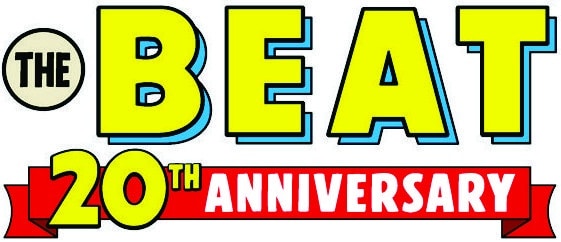
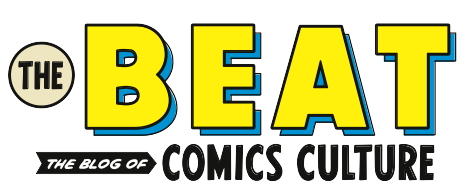



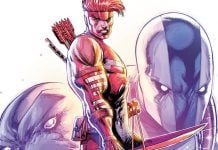




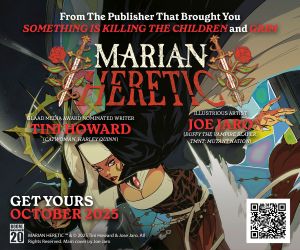
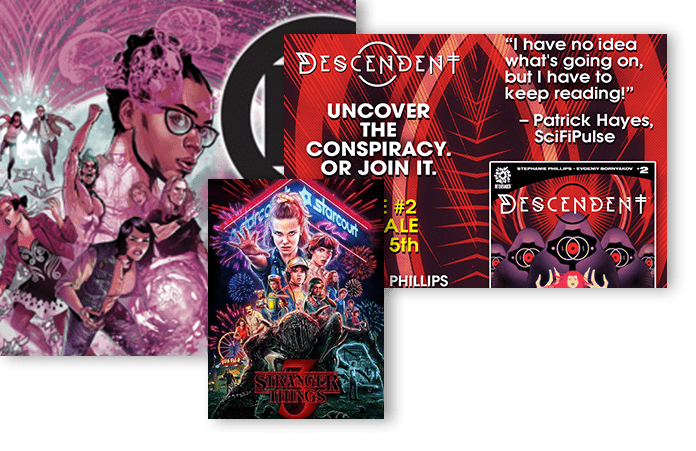
are they prepared for the eventual lawsuit from the Christian Rock band with the same name?
Per the USPTO website, the trademark status for “Family Force 5” and “Family Force Five” are both “dead”/”cancelled.”
Comments are closed.